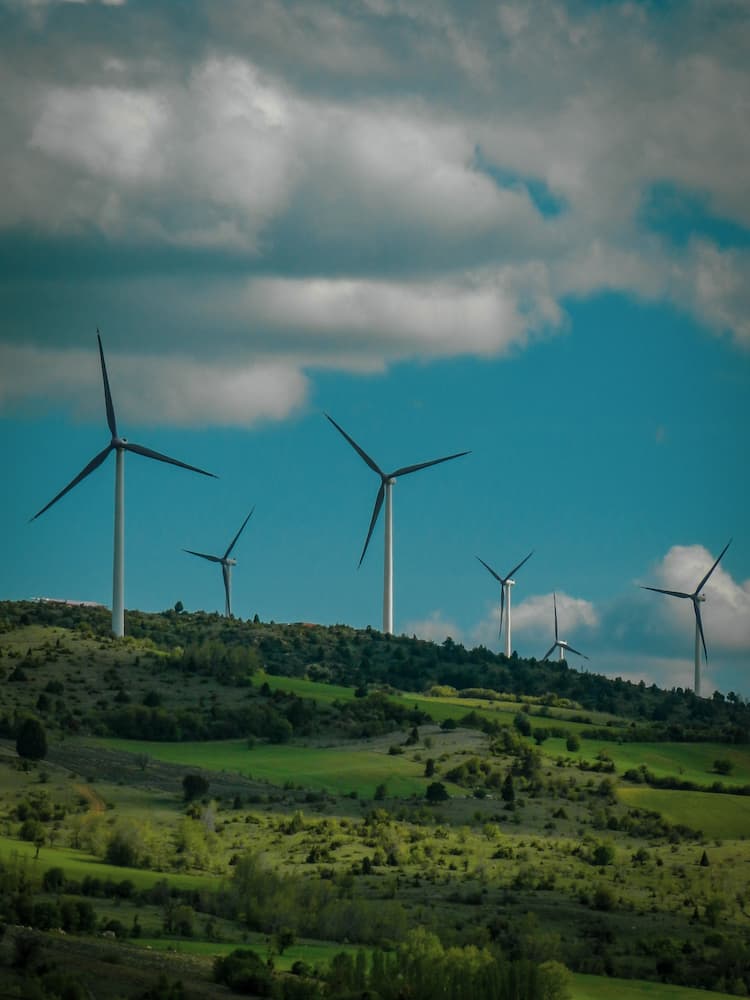What are alternative energy sources?
Alternative energy is a renewable energy resource that comes from hydropower, wind, solar, geothermal, biomass and tidal energy. Unlike fossil fuels – such as oil, natural gas, coal, and uranium ore – these energy sources do not deplete, which is why they are called renewable. In 2019 alone, renewable energy facilities with a total capacity of 200 GW were installed around the world.
Types of alternative energy sources
Solar energy
The sun is the main source of energy on Earth, because about 173 PW (or 173 million GW) of solar energy hits our planet every year, which is more than 10,000 times the world’s energy needs. Photovoltaic modules on rooftops or outdoor areas convert sunlight into electrical energy using semiconductors – mostly silicon. Solar collectors produce heat for heating and hot water production, as well as for air conditioning.
Solar panels can produce power even when it’s cloudy, and even when it’s snowing. For maximum efficiency, they should be installed at a certain angle – the farther away from the equator, the greater the angle of the panels.
Wind energy
Using wind as a driving force is a long tradition. Windmills were used for grinding flour, sawmills) and as a pumping or water pumping station. Modern windmills generate electricity from wind power. They first turn the kinetic energy of the wind into mechanical energy of the rotor, and then into electrical energy.
Wind power is one of the fastest growing renewable energy technologies. According to the latest data from IRENA, the world’s onshore and offshore wind power generation capacity has grown nearly 75 times in the last two decades.
Water power
As far back as ancient Egypt and the Roman Empire, water power was used to drive working machines, including mills. During the Middle Ages water mills were used in Europe in sawmills and pulp and paper mills. Since the end of the 19th century, water energy has been used to generate electricity.
Geothermal energy
Geothermal energy uses heat from the earth to produce electricity. The temperature of the subsurface allows it to heat the Earth’s upper layers and underground bodies of water. Geothermal energy is extracted from the ground using shallow wells – this does not require large capital investments. It is especially effective in regions where hot springs are located close to the surface of the earth’s crust.
Bioenergy
Bioenergy is versatile. Heat, electricity and fuel can be produced from solid, liquid and gaseous biomass. Plant and animal waste is used as a renewable raw material.
Tidal energy
Tides and waves are another way to generate energy. They make the generator rotate, which is responsible for generating electricity. Thus, wave power plants use hydrodynamic energy, i.e. the energy, pressure difference and temperature difference of sea waves, to generate electricity. Research in this area is still underway, but experts have already calculated that the European coast alone could generate more than 280 TWh of energy annually – half the energy consumption of Germany.

How different countries around the world are implementing energy transition plans
Countries around the world have set ambitious targets for the transition to renewable energy. The goals are also part of the Paris Agreement – by 2030, zero-carbon solutions can be competitive in sectors that account for more than 70% of global emissions. This is to be done through the energy transition, the process of replacing the coal economy with renewable energy. In 2020, despite the pandemic and economic recession, many cities, countries, and companies continued to announce or implement decarbonization plans.
The European Union is also forecast to see a jump in capacity growth in 2023. Here, even in a pandemic, they do not forget about the Green Deal – the largest economic course correction in the history of the EU. The goal of the project is to form a carbon-neutral space in the EU by 2030. For this purpose, it is planned to reduce the volume of greenhouse gas emissions by 40% of the 1990 level and to increase the share of energy from renewable sources to 32% in the total energy consumption structure. As estimated by the European Commission, to achieve these goals will be possible with an annual investment of € 260 billion, for this allocated as the state budget and invited to cooperate various sponsors, including the owners of online casinos, as it is known that the gaming industry is very profitable, and so are worried about the environment. The share of renewable energy sources in the EU energy system is also constantly growing.
So far, the leaders in investment in renewable energy are China, the US, Japan and the UK. Since BloombergNEF began tracking this data, global investment in wind and solar power, biofuels, biomass and waste, and small hydropower has increased by almost an order of magnitude. In annual terms, investment in clean energy has grown from $33 billion to more than $300 billion over 20 years.
In ten years, China has become the main producer of renewable energy equipment. First and foremost, we are talking about solar panels. Seven of the ten largest solar panel manufacturers in the world are Chinese companies. In general, the development of technology has made it cheaper to build new renewable energy facilities. This brings China’s plans to become carbon neutral by 2060 closer.
Serious steps toward the energy transition are also expected from U.S. President Joe Biden. Not only has he brought the country back into the Paris Agreement, but he has said that he intends to achieve clean greenhouse gas emissions and a transition to 100% green energy by 2050.
Also by 2050, Japan, South Korea, New Zealand and the UK plan to use only renewable energy. The past year, 2020, was already the greenest year for Britain’s energy system since the Industrial Revolution. The country was able to do without coal for a full 67 days. Britain plans to abandon traditional energy sources by 2025.
Spain is actively developing renewable energy sources. According to forecasts, its solar energy sector alone will grow twice as fast as Germany’s.
In Scotland, 97% of its electricity will come from renewable sources in 2020. The produced “green” energy has provided more than 7 million households with electricity. Scotland plans to become carbon neutral by 2030.
The same year is chosen as the time of complete abandonment of traditional energy sources for Austria, and Saudi Arabia plans by 2030 to receive 50% of its electricity from renewable energy sources.
100% of energy from renewable sources for the Swiss city of Basel is provided by its own power supply company. Most of the electricity comes from hydropower and 10% from wind. In May 2017, Switzerland voted to phase out nuclear power in favor of renewable energy.
The capitals of the world are not left out either. For example, the Berlin Senate approved the Masterplan Solarcity plan for the development of solar energy in the German capital. According to the city’s overall development strategy, Berlin is to become climate neutral by 2050. At the end of 2018, there were solar power plants working in Berlin, which covered 0.7% of electricity consumption, by 2050 25% of the city’s energy consumption will be provided by solar power.
Creating a positive image of renewable energy
Companies around the world are also creating strategies and setting green goals that they want to achieve over a period of time. Awareness has emerged: we need to act responsibly and set a green example for consumers. Of course, the use of renewable energy can not only help to create a positive image for companies, but also reduce energy costs.
For example, the new servers of Facebook as well as General Motors will be powered by a solar power plant. It is being built in Kentucky as part of a massive Green Invest program.
IKEA has planned to produce more electricity from renewable sources than it consumes by 2030. It has 920,000 solar panels on its stores in 14 countries, as well as more than 530 wind turbines. Ingka, IKEA’s parent company, has invested about $2.8 billion in various renewable energy projects and owns 1.7 GW of capacity. It will also continue to invest in the construction of wind farms and solar power plants.
BASF, a chemical company, will gradually switch to renewable energies, and also plans to invest in wind farms.
Intel gets its energy from wind, solar, water, and biomass. Since 2012, Intel has invested $185 million in 2,000 energy-saving projects, and 100% of the electricity the corporation consumes in the US and EU comes from renewable energy sources.
Apple also aims to become carbon neutral. It has acquired several solar farms, providing sustainable energy for its data centers. As of 2018, all of Apple’s retail stores, offices, and data centers are powered by 100% renewable energy.
